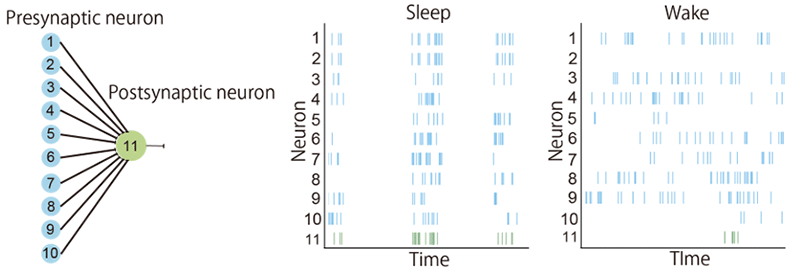In the cerebral cortex, numerous neurons exchange information through junctions known as synapses. The strength of each synaptic connection changes depending on the activity levels of the neurons involved, and these changes are thought to form the basis of learning and memory. There are several established principles governing the relationship between neuronal activity patterns and changes in synaptic strength, referred to as "synaptic learning rules (1) ". Although it is well known that sleep plays a crucial role in learning and memory, how synaptic connections are altered during sleep has remained unclear.
A research group led by Professor Hiroki Ueda of the Graduate School of Medicine, The University of Tokyo, has demonstrated that the strength of synaptic connections in the cerebral cortex during sleep changes depending on synaptic learning rules and the level of neuronal activity during sleep. They revealed that it was possible to theoretically predict the conditions under which "sleep learning (2) " may occur.
The researchers used computational simulations to reproduce the activity of neural networks composed of various types of interconnected neurons, and they investigated changes in synaptic connections during the neural activity observed in the sleep-wake states. These results showed that synaptic connections in the cerebral cortex are strengthened during sleep when specific levels of neural activity were accompanied by typical synaptic learning rules. This finding clarified the conditions under which synaptic strengthening can occur even during sleep, thereby enabling theoretical predictions of when "sleep learning" is possible.
Based on these predictions, these insights are expected to lead to a deeper understanding of the relationship between sleep, learning and memory. Moreover, they may contribute to elucidating the mechanisms of brain disorders associated with sleep disturbances, such as neuropsychiatric conditions.
These findings were published in the online version of the American scientific journal PLOS Biology on June 12, 2025.
This result was achieved in the Ueda Biological Timing Project, a research area of the Exploratory Research for Advanced Technology (ERATO) by the Japan Science and Technology Agency (JST). Under this project, JST pursues "systems biology for understanding humans" using the sleep-wake rhythm as a model system and aims to understand information on "biological time," which transcends from molecules to individual humans living in society.
<Notes>
(*1) Synaptic learning rules
Rules that describe how the strength of synaptic connections between neurons changes depending on the timing and frequency of neural activity. Examples include Hebbian rule and spike-timing-dependent plasticity (STDP).
(*2) Sleep learning
The enhancement of memory and learning performance through the organization and integration of new information by the brain during sleep.
-

Figure 1. Construction of neural network and populational activity during sleep and wakefulness generated by simulation Firing patterns that represent synchronous activity during sleep and desynchronous activity during wakefulness were generated by simulation in a neural network where 10 presynaptic neurons are connected to a single postsynaptic neuron.
© Fukuaki Kinoshita, Systems Pharmacology, University of Tokyo
-

Figure 2. Comparison of synaptic strength during sleep and wakefulness
(Firing rate in wakefulness = Firing rate in sleep)(A) For each synaptic learning rule, the distribution of the change in synaptic strength (after / before) across 1,000 different parameter sets. The “lag” refers to the time difference between the firing of the presynaptic neuron and the postsynaptic neuron.
(B) For each synaptic learning rule and firing rate (i.e., the average firing frequency in the 11-neuron network shown in Figure 1), we calculated the temporal changes in synaptic connections during sleep and during wakefulness and then compared their mean values. Under the Hebbian and STDP rule, synaptic connections are strengthened during sleep compared to wakefulness. The difference is larger especially at lower firing rate of the neural network.
© Fukuaki Kinoshita, Systems Pharmacology, University of Tokyo
-

Figure 3. Comparison of synaptic strength during sleep and wakefulness
(Firing rate in wakefulness > Firing rate in sleep)Temporal changes in synaptic connections during sleep and during wakefulness, and compared their mean values under conditions where the average firing rate during wakefulness (in the 11-neuron network shown in Figure 1) exceeds that of sleep. According to both the Hebbian and STDP rule, synaptic connections become more enhanced during wakefulness than during sleep (consistent with “SHY”) when there is a large difference in firing rate between wakefulness and sleep. On the other hand, when the difference in firing rate is small, synaptic connections become more enhanced during sleep than during wakefulness (consistent with “WISE”).
© Fukuaki Kinoshita, Systems Pharmacology, University of Tokyo
Program Information
- JST ERATO
- Research Project “UEDA Biological Timing”
Journal Information
Fukuaki L. Kinoshita, Rikuhiro G. Yamada, Koji L. Ode, and Hiroki R. Ueda, “A unified framework to model synaptic dynamics during the sleep–wake cycle”, PLOS Biology. Published online June 12, 2025, doi: 10.1371/journal.pbio.3003198
Contact
-
[About Research]
Hiroki R. Ueda, Professor,
Department of Systems Pharmacology, Graduate School of Medicine, The University of Tokyo
Tel:+81-3-5841-3415
E-mail: uedah-tkyumin.ac.jp
-
[About Program]
Fumie Imabayashi
Department of Research Project, JST
E-mail: eratowwwjst.go.jp
